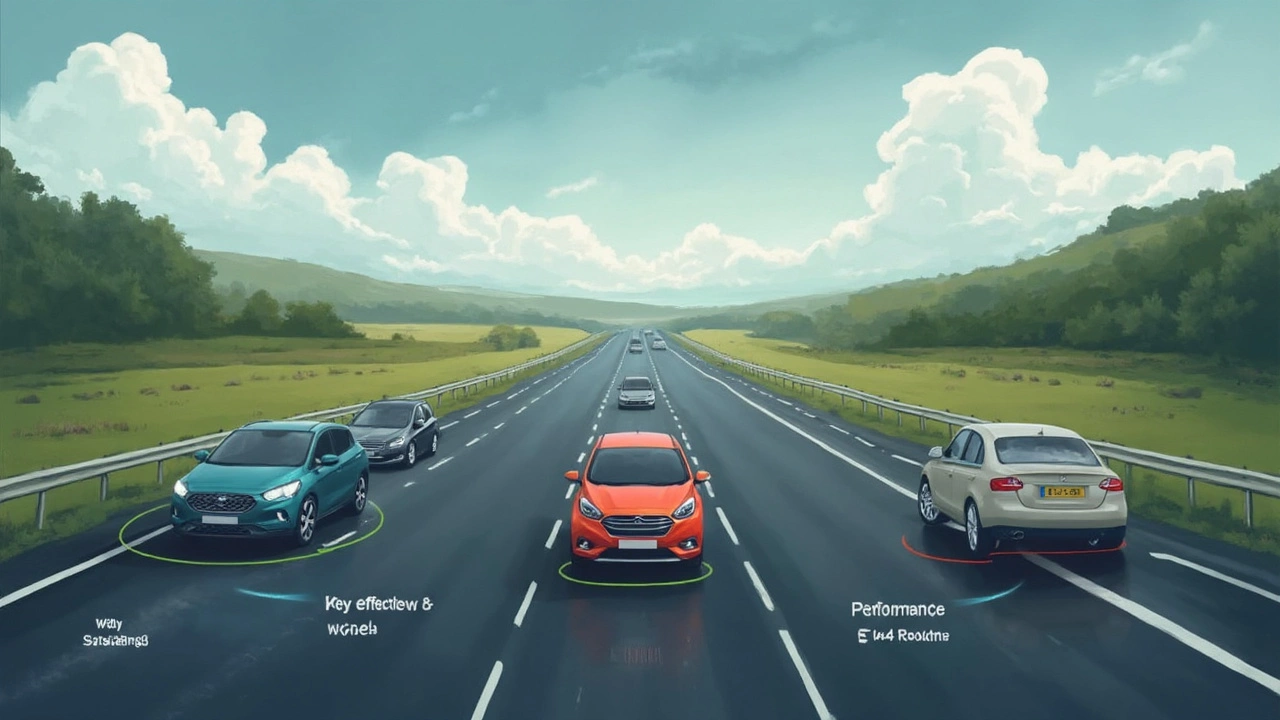If you’re gearing up for a long trip and your ride is sporting wheel spacers, you’re probably wondering if that’s risky or not. Let’s cut through the rumors: yes, you can drive long distance with wheel spacers, but only if you get a few key things right. Slapping on cheap spacers, skipping torque checks, or using the wrong type is asking for trouble.
Wheel spacers push your wheels further out from the hub, usually to make your stance look better, fit bigger tires, or improve handling. But they also change how stress goes through your suspension and bearings. Get this wrong, and you’ll feel it in the steering wheel, or worse—something lets go at 70 mph. Want to avoid disaster? Pay attention to quality, install them the right way, and do those pre-trip checks like your life depends on it (because sometimes it does).
- What Are Wheel Spacers and How Do They Work?
- Are Wheel Spacers Safe for Long-Distance Driving?
- Potential Issues: What Can Go Wrong?
- Maintenance Tips for Stress-Free Trips
- When Should You Avoid Using Them?
What Are Wheel Spacers and How Do They Work?
Wheel spacers are metal rings that fit between your car’s wheel hub and the wheel itself. They push the wheels outward, changing how they sit inside the fenders. This quick add-on fixes clearance issues, helps you fit wider tires, or just makes your car look more aggressive. Most people go for spaces between 5mm to 50mm, depending on the result they want. You’ll usually find them made from either aluminum or steel; aluminum is lighter and resists rust, while steel is bulkier but extra tough.
Here’s how spacers really work: When installed, they change where the wheel mounts to the car—basically, the wheels move further away from the center of the hub. This changes the wheel’s offset. More offset can mean a wider stance, which in some cases gives better stability around turns. But, go too wide, and you can mess with your suspension geometry or put extra wear on bearings and studs.
There are two main types out there:
- Slip-on spacers: These slide right onto the hub, and the wheel then sits over them. They’re easy to install but only safe if you have enough stud length left for your lugs.
- Bolt-on spacers: These actually bolt to your hub, and the wheels bolt into the spacers. These are safer for bigger sizes since they come with their own studs.
The market is full of options, but cheap, poorly made spacers can warp, snap, or trigger vibrations. Always pick spacers made for your exact vehicle. Here’s a snapshot of typical spacer sizes and what they do:
| Spacer Thickness | Typical Use | Common Material |
|---|---|---|
| 5mm - 10mm | Minor fitment fixes, subtle stance change | Aluminum |
| 15mm - 25mm | Clearance for bigger brakes or tires | Aluminum/Steel |
| 30mm - 50mm | Major stance change, off-road use | Steel |
Your main takeaway? Wheel spacers can work well when chosen carefully and fitted right. Don’t go bargain-hunting for these—this is one spot where quality matters.
Are Wheel Spacers Safe for Long-Distance Driving?
This is where everyone wants a straight answer: are you asking for trouble crossing a few states on wheel spacers? The reality is, quality spacers that are installed correctly aren’t likely to fail just because you’re going on a road trip. Factory torque specs, clean studs, and the right fit matter a lot more than distance itself.
Think about it—OEMs like Porsche, BMW, and Ford sometimes use spacers to dial in handling from the factory. But, aftermarket spacers? You’re responsible for getting it right. Go with name brands made from billet aluminum or forged steel, not cheap mystery metal off a discount site. Hub-centric spacers are a must—they center on the hub, not the lug nuts, so you get less vibration and more even stress.
Actual failures are rare if you stick to good brands and don’t cut corners. One independent shop’s customer data showed zero spacer-related failures over 200,000+ miles of long-distance driving. Most spacer problems come from cheap parts, over-torquing, or plain old lazy installs.
| Quality Spacer | Proper Install | Long Distance Issue Rate |
|---|---|---|
| Yes | Yes | < 0.1% |
| No | No | > 10% |
If you skip regular checks (especially after install and every few thousand miles), that’s where things get risky. Bolts can loosen a bit over time, especially after a lot of heat cycling on the highway. After the first 50-100 miles with new spacers, always re-torque. Do a quick hand check whenever you stop for gas or snacks—better safe than limping to the next town with wobbly wheels.
- Use only hub-centric, high-quality spacers
- Follow exact torque specs—don’t eyeball it
- Double-check tightness after big drives or every oil change
Bottom line: good spacers, good install, and some common sense mean long-distance trips aren’t a big deal. Skimp on any of that and you’re rolling the dice the first hundred miles out of town.

Potential Issues: What Can Go Wrong?
Wheel spacers might look like a simple upgrade, but there are some very real things that can go sideways if you don’t pay attention. First, cheap or poorly machined spacers are notorious for fitting badly. If they don’t sit perfectly flush on the hub, expect vibration at speed or, even worse, uneven load on your wheel bearings. That extra leverage messes with your alignment and can kill your bearings or ball joints much faster than normal. No one wants to deal with a fried bearing out in the middle of nowhere.
Another common fail: using the wrong bolt length. Throwing on spacers means your factory wheel bolts or studs can be too short. If the threads don’t bite deep enough, your wheels are barely hanging on. On a long drive, repeated bumps and vibrations can work those bolts loose and send a wheel flying. That’s not just a hassle—it’s a safety nightmare.
Heat can be a problem, too. Long distance driving, especially in the summer, means your brakes and wheels get hot. Low-quality spacers made from cheap alloys might warp under that extra heat, leading to dangerous wobble or even cracking.
Let’s talk about tire wear. Pushing your wheels out changes the load on your tires and steering parts. Over time, this can mean uneven tire wear—especially on the inside shoulders. You’ll notice the car handling a bit differently, or you might hear odd noises from the suspension. If your alignment isn’t spot on before you leave, those issues only get worse with more miles.
- Double-check spacer fit and material; avoid lightweight, no-name brands.
- Make sure bolts or studs are long enough and torqued to spec—use a torque wrench, not just your gut.
- Keep an ear out for weird noises or vibrations, and check everything after your first few hundred miles.
The bottom line is, most of the horror stories with wheel spacers come from cutting corners or ignoring warning signs. If you take shortcuts, things can go really wrong, really fast on a road trip.
Maintenance Tips for Stress-Free Trips
If you want long-distance driving to feel routine with wheel spacers, a bit of hands-on care is non-negotiable. Neglect is what leads to those internet horror stories about wheels flying off. Here’s what actually matters when it comes to making sure your spacers go the distance.
Wheel spacers, just like any part between your wheels and the road, need regular checks before and during your trip. Whether you’re using hub-centric or lug-centric types, how you maintain them makes all the difference.
- Check Torque—Frequently: Bolts and nuts can loosen up over miles of highway driving, especially right after installation. Always torque them to the manufacturer’s recommended spec before the trip, then check again after about 50-100 miles.
- Inspect for Cracks or Warping: Give each spacer a visual check for cracks, unusual wear, or warping. Light corrosion isn’t a disaster, but deep pitting or bent aluminum means it’s time for a replacement.
- Look for Wheel Bearing Play: Spacers can increase bearing stress. Wiggle your wheels with the car jacked up; side-to-side movement means your bearing could be going, and that’s not something you want on a road trip.
- Retorque After Removing the Wheels: Anytime you rotate tires or change a flat, retorque the spacers when you reinstall the wheels.
- Double-Check Stud or Bolt Length: If you’ve changed spacers or wheels, make sure your studs or bolts have enough length—at least 7 full turns is the rule of thumb for safety.
Got a torque wrench? Great. Don’t trust yourself to “tighten by feel.” For reference, the table below shows common torque specs for spacer bolts (but always check your car’s manual or the spacer manufacturer for the exact numbers):
| Vehicle Type | Spacer/Bolt Torque (ft-lb) |
|---|---|
| Passenger Car | 80-100 |
| Light Truck/SUV | 100-120 |
| Heavy Duty Pickup | 120-140 |
Before you head out, keep an eye on tire pressure too. Spacers sometimes lead to uneven tire wear, so watch for unusual tread patterns. If you think something feels off in the steering, pull over and do a quick once-over rather than risking it. A five-minute roadside check can save a lot of headache down the line.
One last thing: pack the right tools. Bring a torque wrench, breaker bar, and any special socket your spacers need. You don’t want to be stranded on the side of the interstate without them.

When Should You Avoid Using Them?
Wheel spacers aren’t always the right choice, especially if you’re thinking about long distance driving. There are some situations where using spacers just doesn’t make sense—or could actually be unsafe.
- Low-Quality or Generic Spacers: If you can’t trace the manufacturer or the spacers look cheap, skip them. Low-quality alloys can bend or crack, and that’s a real risk at highway speeds.
- Incorrect Fitment: If your spacers don’t match your hub and wheel perfectly, you’ll end up with vibrations and could damage your wheel studs, bearings or even the wheels themselves.
- Excessive Thickness: Don’t pick spacers that are too thick (like over 25mm) without checking if your suspension and bearings can handle it. The extra leverage can wear out parts a lot faster. Mechanics often see early bearing failure on cars running thick spacers for months at a time.
- Track Use Only: Some spacers are meant for track days—not real world roads with potholes and unpredictable bumps. If the packaging says "track use only," don’t gamble with them on your cross-country trip.
- Already Worn or Damaged Parts: If your wheel bearings, studs, or suspension parts already have miles on them, adding spacers increases their workload. It’s a bad idea unless you’ve done recent maintenance.
- No Hub-Centric Lip: If your spacers are lug-centric (centered by the wheel bolts) rather than hub-centric (centered by a lip that matches your hub), they won’t be as stable. That can lead to wobble on long hauls.
The table below spells out when spacers are risky versus safe options:
| Scenario | Safe to Use Spacers? | Why/Why Not |
|---|---|---|
| Factory torque tested, hub-centric, moderate thickness | Yes | Designed for daily and long distance driving |
| Unknown brand, no markings, non-hub-centric | No | Unpredictable metal quality; likely to cause vibration/wear |
| Suspension and bearings already worn | No | Extra leverage speeds up failure |
| Track-only labeled spacer, daily highway use | No | Material and design may not stand up to road abuse |
| Spacer thickness over 25mm on stock suspension | Risky | Bearing and suspension stress increases sharply |
If you’re driving a heavy load, running oversized off-road tires, or planning to drive through rough terrain, really think twice and talk to a specialist. And if you notice any new vibration, clunk, or uneven tire wear, pull over and check them out before something breaks. It’s just not worth the gamble when you’re hundreds of miles from help.




